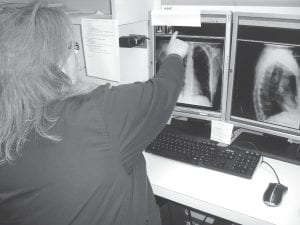X-ray CT Tech Kathy Fladung shows the hospital board the wonders of the new CT computer program that can take multiple overlapping x-ray images and create three-dimensional views out of them. The images can be zipped off to radiology specialists around the country for readings in as few as five minutes any time of the day or night.

Getting a high-tech medical scan and an expert’s opinion on what it means is going to be faster than ever at the Cook County North Shore Hospital by the end of the summer. The Radiology Department is upgrading its CT equipment – enabling complex three-dimensional views to be created on a computer screen from multiple, overlapping x-ray images and sent immediately to experts in many places.
The new equipment will allow specialists to receive the images quickly and provide consultations in as few as five minutes. It will be able to provide simpler images as well, avoiding more complex scans when they are not necessary. The hospital will no longer need to spend $75 a day for couriers to deliver films.
The new system is being implemented a little at a time. “We’ve had nothing but rave review by the physicians,” said X-ray CT Tech Kathy Fladung.
The hospital contracts with a radiology group that provides 24-hour service. Specialists from around the country read the scans. Hospital staff are working with some of the same radiologists from case to case, getting to know them on a first-name basis.
Patients will also be able to get a CD of their own CT scan to take home and show to their friends and family like people used to show vacation slides.
April income high
The reimbursement picture continues to be dire for critical access hospitals – rural hospitals with emergency facilities. Hospital board member Kay Olsen reported on May 19 that at a recent conference she learned, “Basically, it’s bleak and bleaker!”
One month’s worth of heavy traffic in the inpatient and swing bed departments, however, kept the projected year-to-date loss of $1,160,253 down to $429,311 at the end of April. Revenue that month was 34.3 percent higher than the amount that had been budgeted. The bulk of the business came in from diabetic wounds, pneumonia, and joint replacements.
Billing for services rendered is rather complex. “Bill a dollar, get a dollar – right?” Controller Yvonne Gennrich asked the board. “No!”
The hospital gets reimbursed from some of its major payors— such as Medicare—less than it costs to deliver certain services. It tries to make up for those losses by charging more than the actual cost for other services. Medicare, a significant source of hospital revenue, reimburses Minnesota hospitals less than some southern states because of the state’s history of keeping its costs down, an irony that frustrates hospital administrators.
Swing beds receive better reimbursement rates than nursing home beds. Medicare will pay for up to 100 days in a swing bed, and it reimburses critical access hospitals at a higher rate than other hospitals. North Shore Hospital is in the process of a modeling study that will consider various scenarios and what would maximize revenue and minimize loss – such as having more people utilizing swing beds instead of entering the nursing home. The hospital can have no more than 16 beds in order to retain its critical access status, however, and the number of swing beds it can have is limited.
Meanwhile, the hospital works hard to stay afloat, and hospital staff hope the community will make full use of the many services—such as lab, radiology, physical therapy, and even swing beds for patients coming back from surgery elsewhere— that it provides.


Loading Comments